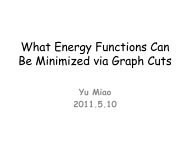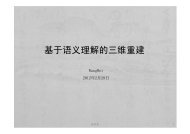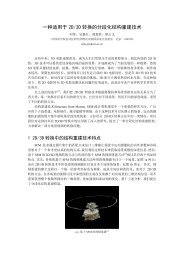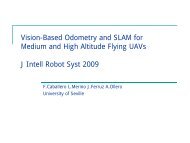Rotationally Invariant Descriptors using Intensity Order ... - IEEE Xplore
Rotationally Invariant Descriptors using Intensity Order ... - IEEE Xplore
Rotationally Invariant Descriptors using Intensity Order ... - IEEE Xplore
Create successful ePaper yourself
Turn your PDF publications into a flip-book with our unique Google optimized e-Paper software.
This article has been accepted for publication in a future issue of this journal, but has not been fully edited. Content may change prior to final publication.<br />
<strong>IEEE</strong> TRANSACTION ON PATTERN ANALYSIS AND MACHINE INTELLIGENCE 21<br />
1<br />
0.95<br />
0.9<br />
0.85<br />
0.8<br />
0.75<br />
0.7<br />
MR(192)<br />
SR−1(48)<br />
SR−2(48)<br />
0.65<br />
SR−3(48)<br />
SR−4(48)<br />
SIFT(128)<br />
0.6<br />
0 0.1 0.2 0.3 0.4 0.5<br />
(a) MROGH<br />
1<br />
0.95<br />
0.9<br />
0.85<br />
0.8<br />
0.75<br />
0.7<br />
MR(256)<br />
SR−1(64)<br />
SR−2(64)<br />
0.65<br />
SR−3(64)<br />
SR−4(64)<br />
SIFT(128)<br />
0.6<br />
0 0.1 0.2 0.3 0.4 0.5<br />
(b) MRRID<br />
1<br />
0.95<br />
0.9<br />
0.85<br />
0.8<br />
0.75<br />
0.7<br />
MR(512)<br />
SR−1(128)<br />
0.65<br />
SR−2(128)<br />
SR−3(128)<br />
SR−4(128)<br />
0.6<br />
0 0.1 0.2 0.3 0.4 0.5<br />
(c) SIFT<br />
Fig. 10. Performance comparison between multi-support regions and a single support region when <strong>using</strong> (a) MROGH,<br />
(b) MRRID and (c) SIFT respectively. SR-i is the result <strong>using</strong> the ith support region and MR is the result <strong>using</strong> multisupport<br />
regions. The performances of MROGH and MRRID are significantly improved when <strong>using</strong> multi-support regions, while<br />
the improvement of SIFT is much less significant.<br />
of DAISY also uses one dominant orientation for each interest point. Therefore, all the evaluated<br />
methods (DAISY, SIFT, RIFT, MROGH and MRRID) have the same number of features. So the<br />
obtained numbers of correspondences are the same too. In our experiments (Intel Core2 CPU<br />
1.86GHz), the time of constructing a descriptor for a feature point is: 1.6ms for RIFT, 12.3ms for<br />
DAISY, 4.6ms for SIFT, 8.3ms for MROGH, 1.9 ms for MROGH with a single region, 18.5ms<br />
for MRRID and 4.8ms for MRRID with a single region.<br />
1) Performance on the Oxford Dataset: The proposed descriptors were evaluated on the<br />
standard Oxford dataset, in which image pairs are under various image transformations, including<br />
viewpoint change, scale and rotation changes, image blur, JPEG compression and illumination<br />
change. They are shown in Fig. 2 in the supplemental material. In each row, the images from<br />
the 2nd to the 5th columns are matched to the 1st image separately. As in [22], we evaluated<br />
the performance of descriptors <strong>using</strong> both Hessian-Affine and Harris-Affine detectors [9]. Due<br />
to paper length limit, we only give the results with Hessian-Affine regions in Fig. 11. Please<br />
see Fig. 3 in the supplemental material for the results with Harris-Affine regions. It can be<br />
seen from these results that although the performance of each descriptor varied with different<br />
feature detectors (Hessian-Affine or Harris-Affine in this experiment), the relative performance<br />
among different descriptors is consistent with different feature detectors. The results show that<br />
MROGH and MRRID outperform the other evaluated local descriptors in all the tested cases.<br />
Such a good performance of MROGH and MRRID may be attributed to their well-designed<br />
November 26, 2011 DRAFT



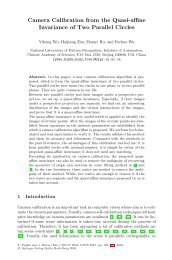
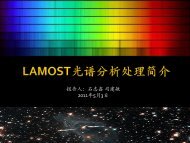
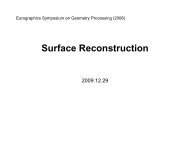
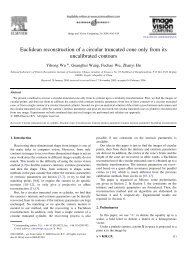
![Accurate, Dense, and Robust Multi-View Stereopsis (PMVS) [1,2,3]](https://img.yumpu.com/19388840/1/190x135/accurate-dense-and-robust-multi-view-stereopsis-pmvs-123.jpg?quality=85)


